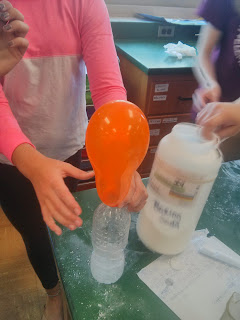On of my main goals in my 7th grade science class is to expose students to the scientific method and get students doing their own experiments. No matter how many time I work on things like variables, controls and constants, it's hard for students to understand these concepts without some hands on experience. Two or three times a year I have students complete, what I call, an Inquiry Project. In this project, students get the opportunity to develop their own problem/question to investigate.
I help students to develop a problem/question and then they are to write the hypothesis, procedures and materials by themselves. In addition, I provide them with some analysis questions asking things about variables and constants.
Below are some pictures of some of the activities that my students were conducting.
How does the amount of baking soda effect how much carbon dioxide is produced when mixed with vinegar?
How does the number of mentos effect how big the explosion is when mixed with diet coke?








